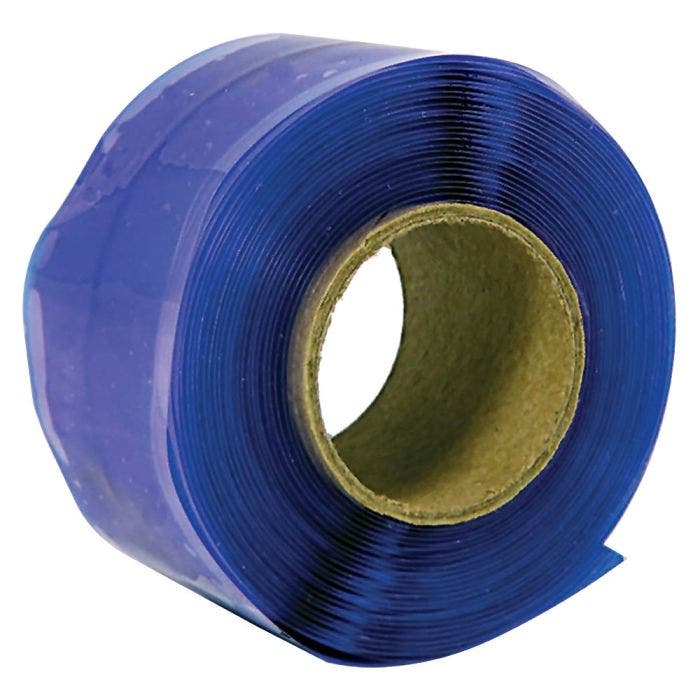Self Fusing Silicone Tape Blue by A.M. Leonard
In stock
Only 2 left
SKU
A24125
$7.85
SEE ALL TIER PRICING
Buy 3 for $7.60 each and save 3%Buy 6 for $7.35 each and save 6%
READ MORE...
Product Information
Product Specs
- Name: Leonard Self Fusing Silicone Tape Blue
- Color: Blue
- Width: 1 inch
- Thickness: 20 mils
- Length: Sold in 10 foot rolls
- Bonds to: Itself
- Sealing: Airtight and waterproof
- Insulating Capacity: Up to 400 volts per mil
- Resistance: UV, oil, salt, chemical based degradation
- Temperature Range: -65*F to 500*F
- Stretch: More than 300%
- Easy to Remove: Can be removed with a knife without leaving a messy residue
- Origin: Made in the USA
- Warranty: Backed by a lifetime warranty
Product Warranty Information
- This product is covered by A.M. Leonard's Down-to-Earth guarantee. Click here for more details.
Product Features
- Leonard Self Fusing Silicone Tape Blue
- Perfect for even the most extreme environments!
- Measures 1 inch in width and 20 mils in thickness
- Binds to itself to create an airtight and waterproof seal
- Insulates up to 400 volts per mil and resists UV, oil, salt, and chemical based degradation
- Survives extreme temperature fluctuations from 65*F to 500*F and stretches more than 300%
- Made in the USA and backed by our lifetime warranty!
Product Shipping Weight
- .1 pounds
Frequently Asked Questions
1. What are some tips for designing a garden landscape?
Consider the climate, soil type, and available sunlight when choosing plants for your garden. Use variety in plant height, texture, and color to create visual interest. Incorporate hardscaping elements like walkways and seating areas to add structure and functionality to the space.
2. How do I choose the right fertilizer for my garden?
Consider the type of plants in your garden and their specific nutrient needs. Look for a fertilizer that matches the nutrient requirements of your plants. Pay attention to the nitrogen, phosphorus, and potassium ratios in the fertilizer and choose one that matches the needs of your plants at their specific growth stage.
3. How can I prevent pests from damaging my garden?
Some preventative measures include keeping the garden clean of debris, using barriers and covers to keep pests away, and planting pest-repelling plants. Consider using natural solutions like insecticidal soap, neem oil, or companion planting to repel pests.
4. How often should I water my plants?
The frequency of watering will depend on the type of plants, the climate, and the soil type. Generally, most plants require about an inch of water per week, but this can vary. Check the soil regularly and water when the top inch feels dry to the touch.
Consider the climate, soil type, and available sunlight when choosing plants for your garden. Use variety in plant height, texture, and color to create visual interest. Incorporate hardscaping elements like walkways and seating areas to add structure and functionality to the space.
2. How do I choose the right fertilizer for my garden?
Consider the type of plants in your garden and their specific nutrient needs. Look for a fertilizer that matches the nutrient requirements of your plants. Pay attention to the nitrogen, phosphorus, and potassium ratios in the fertilizer and choose one that matches the needs of your plants at their specific growth stage.
3. How can I prevent pests from damaging my garden?
Some preventative measures include keeping the garden clean of debris, using barriers and covers to keep pests away, and planting pest-repelling plants. Consider using natural solutions like insecticidal soap, neem oil, or companion planting to repel pests.
4. How often should I water my plants?
The frequency of watering will depend on the type of plants, the climate, and the soil type. Generally, most plants require about an inch of water per week, but this can vary. Check the soil regularly and water when the top inch feels dry to the touch.
Write Your Own Review


